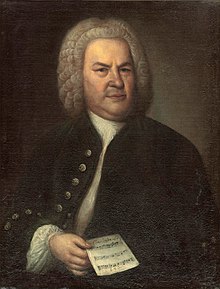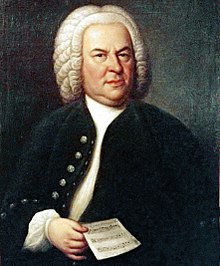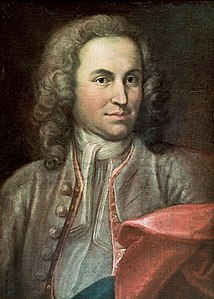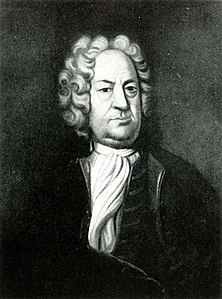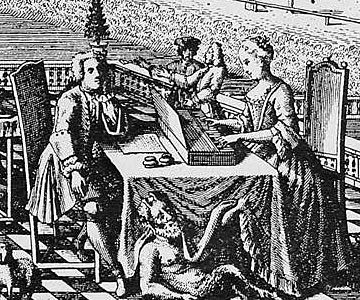Kapellmeister, from German Kapelle (chapel) and Meister (master), literally "master of the chapel choir", designates the leader of an ensemble of musicians. Originally used to refer to somebody in charge of music in a chapel, the term has evolved considerably in its meaning and is today used for denoting the leader of a musical ensemble, often smaller ones used for TV, radio, and theatres.

Christian Friedrich Henrici, writing under the pen name Picander, was a German poet and librettist for many of the cantatas which Johann Sebastian Bach composed in Leipzig.
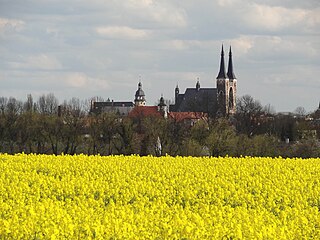
Köthen ( ) is a town in Germany. It is the capital of the district of Anhalt-Bitterfeld in Saxony-Anhalt, about 30 km (19 mi) north of Halle.

Gottfried Heinrich Stölzel was a German composer of the Baroque era.
Throughout his life as a musician, Johann Sebastian Bach composed cantatas for both secular and sacred use. His church cantatas are cantatas which he composed for use in the Lutheran church, mainly intended for the occasions of the liturgical year.

Elias Gottlob Haussmann was a German painter in the late Baroque era. Haussmann served as court painter at Dresden, and from 1720, as the official portraitist at Leipzig. He is mostly known for his portrait of Johann Sebastian Bach which was painted in 1746.

Johann Sebastian Bach was a German composer and musician of the late Baroque period. He is known for his orchestral music such as the Brandenburg Concertos; solo instrumental works such as the cello suites and sonatas and partitas for solo violin; keyboard works such as the Goldberg Variations and The Well-Tempered Clavier; organ works such as the Schubler Chorales and the Toccata and Fugue in D minor; and choral works such as the St Matthew Passion and the Mass in B minor. Since the 19th-century Bach Revival, he has been generally regarded as one of the greatest composers in the history of Western music.

Lorenz Christoph Mizler von Kolof was a German physician, historian, printer, mathematician, Baroque music composer, and precursor of the Enlightenment in Poland.

Jesus nahm zu sich die Zwölfe, BWV 22, is a church cantata by Johann Sebastian Bach composed for Quinquagesima, the last Sunday before Lent. Bach composed it as an audition piece for the position of Thomaskantor in Leipzig and first performed it there on 7 February 1723.

Johann Adolph Scheibe was a German-Danish composer and significant critic and theorist of music. Though much of his theoretical work survives, most of his compositions are lost, though the extant ones demonstrate a style between the Baroque and Classical periods.

Johann Sebastian Bach composed the secular cantata Die Zeit, die Tag und Jahre macht, BWV 134.1, BWV 134a, while he was in the service of the court of Leopold, Prince of Anhalt-Köthen. Bach wrote the work as a serenata for the celebration of New Year's Day 1719.
As Thomaskantor, Johann Sebastian Bach provided Passion music for Good Friday services in Leipzig. The extant St Matthew Passion and St John Passion are Passion oratorios composed by Bach.
The Weimarer Passion, BWV deest, is a hypothetical Passion oratorio by Johann Sebastian Bach, thought to have possibly been performed on Good Friday 26 March 1717 at Gotha on the basis of a payment of 12 Thaler on 12 April 1717 to "Concert Meister Bachen". It is one of several such lost Passions. Both the text and music are lost, but individual movements from this work could have been reused in latter works such as the Johannes-Passion. At one time, it was thought that the work set chapters 26 and 27 of the Gospel of Matthew to music, with interspersed chorales and arias, but current consensus is that it is possible that the text reflected a synopsis of two or more Gospel texts, as well as the interspersed chorales and arias.

Höchsterwünschtes Freudenfest, BWV 194, is a church cantata by Johann Sebastian Bach. He composed it in Leipzig for dedication of the church and organ at Störmthal on 2 November 1723.
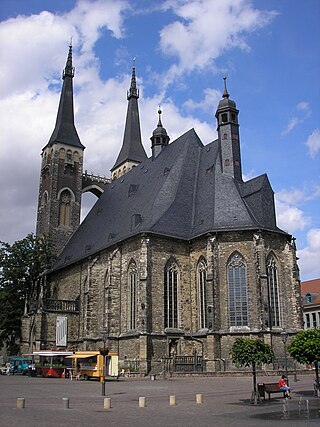
Lobet den Herrn, alle seine Heerscharen, BWV 1147, BWV Anh. 5, is a church cantata text by Christian Friedrich Hunold which was performed, most likely in a setting by Johann Sebastian Bach, for the twenty-fourth birthday of Prince Leopold of Anhalt-Köthen on 10 December 1718. The composition is lost, but its libretto survives in a 1719 print.

The first major biographies of Johann Sebastian Bach, including those by Johann Nikolaus Forkel and Philipp Spitta, were published in the 19th century. Many more were published in the 20th century by, among others, Albert Schweitzer, Charles Sanford Terry, Christoph Wolff and Klaus Eidam.

The 1754 obituary of Johann Sebastian Bach is usually called the Nekrolog. It was published four years after his death.

On Trinity Sunday 27 May 1725 Johann Sebastian Bach had presented the last cantata of his second cantata cycle, the cycle which coincided with his second year in Leipzig. As director musices of the principal churches in Leipzig he presented a variety of cantatas over the next three years. New cantatas for occasions of the liturgical year composed in this period, except for a few in the chorale cantata format, are known as Bach's third cantata cycle. His next cycle of church cantatas, the Picander cycle, did not start before St. John's Day 24 June 1728.
